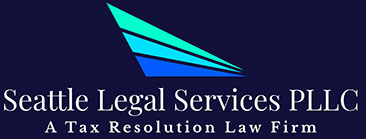
The Internal Revenue Service commonly issues levies on taxpayers who have repeatedly failed to make arrangements to repay their tax debt. If you’re employed and carrying delinquent debt, the IRS will eventually issue a levy to your employer to collect your unpaid tax balance.
This kind of levy is often issued via Form 668-W. If your employer has told you that they received this form, also called a W-2 garnishment, read on to learn more and figure out your next steps. Or contact us at Seattle Legal Services PLLC for help today.
What Is Form 668-W?
Form 668-W is a notice of IRS wage garnishment. The IRS generally uses this notice to issue a levy on an individual’s wages, salary, or other income. These letters are sent directly to employers as it is their responsibility to turn over any ‘property’ they have that belongs to the person being levied against.
For the IRS, ‘property’ can refer to salary, wages, fees, bonuses, and even retirement or pension income. In other words, the IRS sends this form to employers to let them know the IRS is seizing your wages. This form gives your employer instructions on how to comply.
What is a wage levy?
A wage levy, or wage garnishment, is when the IRS seizes part of your wages in order to collect a tax debt you owe. Wage levies are continuous, meaning they will continue until:
- You pay your tax debt in full.
- You apply for a levy release due to financial hardship.
- The IRS’ collection statute of limitations expires.
- You make an agreement with the IRS to pay your debt, like a payment plan or an offer in compromise, and the IRS agrees to stop the wage garnishment.
Many employers and tax professionals will refer to Form 668-W as the W-2 levy or garnishment because it commonly attaches to continuous payments like wages.
What does the notice say?
Notice 668-W lists the name and address of the taxpayer (employee) and is addressed to the employer. It provides details regarding the amount of tax debt owed, including the total amount due with interest and penalties.
The notice goes on to state that this isn’t a bill that the employer owes but rather a notice of levy to collect money owed by the taxpayer (employee). It says that the levy requires the employer to turn over the employee’s wages, salary, and other forms of income until the levy is released.
The notice gives detailed instructions for the employer to fulfill the request, according to the Internal Revenue Code.
What Should Employers Do When They Receive 668-W?
Regardless of how your employer feels about helping the IRS garnish your wages, they are legally required to comply with the levy. If they fail or refuse to comply, they themselves can be subject to liability for the taxes owed, in addition to a penalty equal to 50% of the total amount owed.
For example, if an employer fails to garnish your wages correctly, they could become personally responsible for your tax debt, including penalties and interest. If you owed the IRS $5,000 in back taxes, your employer could become liable for that amount, plus another $ 2,500 penalty fee.
When an employer receives Form 668-W, they are required to follow the instructions to begin garnishing your wages after at least one full pay period has passed. Employers may receive either Form 668–W(ICS) or 668-W(C)DO – neither should be ignored or dismissed.
After they receive this letter, employers will have you complete the enclosed paperwork and return it within three days. Make sure you complete this paperwork or your garnishment may be higher than needed. Your employer will then use that information to determine how much to withhold from your paycheck.
What Should You Do if Your Boss Receives This Form?
If your boss notifies you that they have received Form 668-W, they’ll give you some documentation to complete. This is a Statement of Dependents and Filing Status, and it will help your employer determine how much of your wages to garnish. On this document, you’ll note your filing status and, crucially, the number of dependents you claim on your tax return.
You’ll have three working days to return this form. If you don’t return it in time, your employer might have to proceed without your input. In that case, you’ll be garnished as a single person with no dependents.
If you’ve got dependents, it is vital that you return a Statement of Dependents and Filing Status to your employer ASAP. Once you’ve returned those papers, you should expect a smaller paycheck. You won’t be obliged to take any further action, but you might want to try and seek some resolution rather than continue to have your wages garnished.
If you haven’t already done so, at this point, it might be wise for you to contact the IRS directly about your debt. You should also seriously consider finding a tax debt expert who can help you navigate this process.
A qualified expert can help you take the right steps in a timely manner in order to make some arrangements with the IRS, and hopefully have the levy released.
If you’re worried that wage garnishment might cause significant financial hardship for your family, you may be eligible to file for extreme hardship with the IRS.
How Much of My Wages Can the IRS Garnish?
The amount that the IRS can garnish from your wages after Form 668-W is issued depends entirely on your dependents and filing status. Because this levy is issued following attempts to notify you of your tax debt, and your subsequent failure to pay, the IRS views wage garnishment quite seriously.
Rather than looking at how much they should take from your wages, the IRS figures out how much you should be left with each month so that you can reasonably get by. The IRS uses Publication 1494 to determine how much of your wages should be exempt from the levy, estimating the minimum amount they think you can survive on.
In 2023, if you are married and filing jointly with two dependents, the IRS will leave you with $713.45 per week. If you’re single with no dependents, $266.35 is what you’ll be left with per week after wage garnishment.
For most people, that is simply not enough to live on. These exempted allowances are very low, which reflects the severity of your situation in the eyes of the IRS. Ideally, you can try to avoid any wage garnishment by making arrangements with the IRS before they send Form 668-W.
However, if your boss has already received this form, you can contact a tax debt professional to figure out the best way forward and get your garnishment lifted as soon as possible. At Seattle Legal Services we’ve got many years of experience with cases like this.
How to Stop a Wage Garnishment
Wage levies are continuous, meaning they will last until the tax liability is paid in full. However, there are circumstances that allow you to have a garnishment released, including the following:
- The levy was issued after the collection statute expiration date (CSED).
- Releasing the levy would allow you to pay the taxes back faster.
- The levy is causing financial hardship.
- You agree on a payment plan with the IRS that satisfies the release of the levy.
Financial hardship
The IRS states that a levy on your wages may be released if you file for financial hardship. You can contact the number listed on the Form 668-W and explain your situation.
Note that according to the IRS, a levy release is not the same as an exemption. You’ll still owe the full debt, but the IRS will work with you to establish a payment plan or take other steps to help you pay off the balance.
FAQs About Form 668-W and Wage Garnishment
Got questions? You’re not alone. The United States has one of the most complicated tax codes in the world, and the agency’s collection process can also be very complicated. Take a look at these FAQs.
Why is there a levy on my paycheck?
The IRS issues levies against your paycheck when you have failed to pay your tax debt. Typically, wage garnishment comes as a final resort for the IRS to collect your taxes owed, but generally, wage garnishments are used before seizing your personal and real assets.
If your employer has been issued a levy to garnish your wages, you should seek help from a dedicated tax professional, regardless of whether you believe the levy is correct or not.
How long do wage garnishments last?
Wage garnishments will remain in place until the total tax liability, penalties, and interest are paid in full. However, in some cases, the IRS will remove a wage garnishment if you negotiate a payment plan with them.
You might also be able to prove that the levy will put your family under severe financial hardship, or convince them that you’ll be able to pay the debt back faster if they release the levy. In any case, you should consider hiring a tax professional to help you navigate your options.
How will your employer be notified?
Your employer must continue to garnish your wages, as instructed by the IRS until the levy is released. When that happens, the IRS will send your employer Form 668-D.
Does quitting your job help avoid wage garnishment?
Quitting your job will help you avoid wage garnishment, but only until you find employment again. Once the IRS is aware of your new employment, your new employer will soon be issued with Form 668-W.
Can your employer fire you for a wage garnishment?
You cannot be fired for a single wage garnishment. However, if you have more than one garnishment, the rules vary from state to state. Check with the labor laws in your state to be sure.
Get Help With Form 668-W
If your employer has received Form 668-W, you might understandably be extremely worried. Don’t let your worry stop you from taking action – you’ve got options, and a qualified tax attorney can help you ensure that you handle things correctly.
You don’t have to let the IRS garnish your wages, and you don’t have to deal with the IRS alone, either. Our team at Seattle Legal Services is expertly placed to provide the guidance and direction you need to deal with wage garnishment. Contact us for help today.
